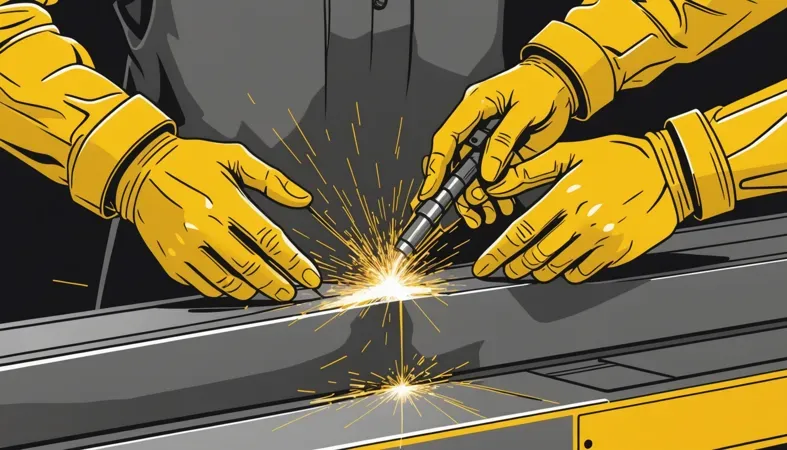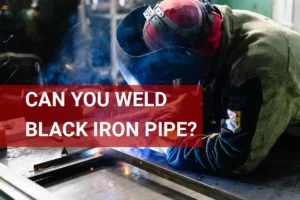Can You Weld Brass? Understanding Techniques, Precautions, and Benefits
Published on: June 21, 2025 | Last modified: March 4, 2025
By: Joe Carter
Brass is an alloy made primarily of copper and zinc. It’s known for its shiny appearance and corrosion resistance.
It’s a question I’m often asked: can you weld brass? Knowing the answer is important because brass behaves differently than steel. From my experience, quality and technique are crucial when welding brass to prevent issues.
In this guide, we’ll cover brass types and their weldability, prerequisites before welding, steps to effectively weld brass, essential safety precautions, welding methods for brass, factors that impact weldability, common challenges you might face, aftercare tips, benefits of welding brass, practical use cases, and comparisons to alternatives. Want to know if you can weld brass to steel? We’ve got it all!
Contents
- Can You Weld Brass?
- What is Brass?
- Types Of Brass and Their Weldability
- Before You Start (Prerequisites)
- Steps to Welding Brass
- Essential Precautions
- Types Of Welding for Brass
- Factors Affecting Brass Weldability
- Understanding Brass Alloys in Welding
- Brass Welding Techniques Overview
- Common Issues You Might Encounter
- Aftercare, Inspection, and Advanced Tips for Welding Brass
- Benefits Of Welding Brass
- Use Cases Of Brass Welding
- What Are the Alternatives to Welding Brass
- Frequently Asked Questions (FAQs)
- Conclusion
- References
Can You Weld Brass?
Yes, you can weld brass, but it’s tricky. Brass has a high thermal conductivity, making it hard to control heat. The best way is to use TIG welding with silicon bronze filler for sturdy joints.
What is Brass?
Brass is an alloy primarily made of copper (Around 55-95%) and zinc (5-45%). Its composition combines the strength of copper with the malleability of zinc. The melting point of brass typically ranges from 900°C to 940°C (1,650°F to 1,720°F). Brass has a density of approximately 8.4 g/cm³ (0.303 Lb/in³), making it lightweight yet strong for various applications.
Welding brass can be tricky due to its high zinc content, which affects its behavior. I’ve experienced that choosing the right welding technique is crucial when joining brass items.
In a decorative project for a local artists’ fair, I used brass for its shine and durability. I had to decide whether to weld brass to brass or to use different materials. Techniques like TIG welding brass helped me achieve the desired aesthetic while ensuring strong joints, which was vital for my project.
Types Of Brass and Their Weldability
What are the types of brass and their welding possibilities?
-
Red Brass
Red brass contains about 85% copper, making it strong and corrosion-resistant. You can weld red brass using special procedures. For this, employing a TIG (Tungsten Inert Gas) process with a brass welding rod helps to minimize oxidation, which is crucial in copper welding applications.
When considering the safety of individuals who work in welding professions, it is important to understand how their work environment and activities can influence medical diagnostics like MRIs. Discover more about MRI considerations for welders.
-
Yellow Brass
Yellow brass consists of copper and zinc in varying proportions, typically 60-70% copper. It can be welded, but it requires care. Use a low-heat application to avoid distortion and a filler that matches its composition.
-
Leaded Brass
Leaded brass contains lead for improved machinability, but it’s tricky to weld. Welding is not recommended since lead can produce harmful fumes. Instead, consider soldering as a safer alternative to join pieces, preserving the integrity of the brass.
-
Naval Brass
Naval brass is designed for marine environments and is made of copper, zinc, and a small amount of tin for added strength. You can weld it with caution. Preheat the brass to at least 200°F (93°C) and use welding rods specified for naval brass to achieve a strong weld.
-
Aluminum Brass
Aluminum brass contains aluminum to enhance corrosion resistance, particularly in seawater. You can weld it, but it requires caution. Typically, use a TIG setup with filler material that matches aluminum brass specifications. When welding, it is crucial to be aware of the risk of electric shock that can occur without proper safety measures.
We have now covered various types of brass and their weldability. Next, we will examine the necessary prerequisites before starting.
Before You Start (Prerequisites)
What do you need to weld brass?
- TIG Welder: You need a TIG welder, like the Miller Syncrowave 200. It’s essential for controlling heat input when welding brass.
- Brass Filler Rod: You need a specific brass filler rod, such as Harris 1/16” (1.6 Mm). This is crucial for securely joining brass.
- Argon Gas: You need argon gas, such as an Industrial Grade Argon Cylinder (Standard Size: 20 Cu Ft or ~0.57 M³). It protects the weld pool from contamination during the process.
- Heat Sink: You need a heat sink, like a copper block. It absorbs excess heat and prevents warping while welding.
So far we covered the necessary prerequisites for welding. Next, let’s look at the specific steps involved in welding brass.
Steps to Welding Brass
Here are the steps for successful brass welding. Follow these key actions to connect brass components effectively.
-
Set Up Your Welding Parameters
Start by adjusting your welding machine settings. For TIG welding, set the current to 80-120 Amperes (A). For MIG welding, use a solid wire with a diameter of 0.030 inches (0.762 Mm). Ensure a consistent welding speed to prevent overheating.
A steady hand and correct settings make a difference. Too much heat? You’ll melt and warp the brass. Too little? The weld won’t penetrate properly, leading to weakness. Find that perfect balance.
-
Prepare the Brass Surface
Clean the brass parts with a degreaser to remove dirt or oil. Follow this with light sanding using fine-grit sandpaper to enhance adhesion. Impurities can lead to a weak bond. After sanding, wipe the surface with a damp cloth to remove dust.
Proper surface prep is crucial! Avoid any residue. I learned that even small particles can ruin weld quality. Take extra time to clean; you’ll appreciate it later.
-
Weld the Brass Items Together
Now it’s time to weld. Hold the torch at a 60-degree angle, maintaining a distance of about 1/8 inch (3.175 Mm). For MIG, weave back and forth slightly while moving along the seam. This technique ensures better coverage and a strong bead.
When I first welded brass, keeping the torch at the right angle was tough. My weld had inconsistent spots. Maintain that angle and pay attention to your feed rate. Rushing leads to issues later.
-
Check for Thorough Fusion
After welding, closely inspect the seams for gaps or weak points. Ensure each spot shows a solid connection and is free from cracks. If you find imperfections, grind down the area and apply more filler as needed. Having a properly sized work surface is crucial for efficient results, so find out optimal welding table height.
My biggest mistake was ignoring small gaps, thinking they’d be fine. They weren’t. I had to redo the entire piece! Stay vigilant; it’ll save you time and hassle.
-
Clean the Welded Joint
After inspecting your weld, use a wire brush or grinder to clean the joint thoroughly. This process removes any slag or oxidation. You can also use a chemical cleaner designed for brass to restore its shine, which is crucial for appearance and longevity.
A little cleanup goes a long way. The first time, I left it uncleaned, and the weld oxidized quickly. Avoid that mistake; treat your weld as a piece of artwork, and it will last.
That covers the steps involved in welding brass. Let’s now take a look at important precautions to consider.

Essential Precautions
Let’s explore safety tips for welding brass.
- Wear a Proper Welding Mask: It protects your eyes from harmful UV rays. I recommend a Miller Digital Elite helmet for best results.
- Use Fire-Resistant Clothing: This reduces heat-related injuries, like metal shavings and splatter. Choose natural fabrics like cotton or specialized welding jackets.
- Ensure Good Ventilation: Adequate airflow helps reduce harmful fumes and gases from brass. Use a fan or work in a well-ventilated area.
- Keep a Fire Extinguisher Handy: Stay prepared for unexpected flare-ups; a Class B extinguisher is highly recommended.
Remember, prioritizing safety keeps you and your workspace accident-free.
We’ve wrapped up essential precautions for welding. Next up, we’ll look at the different types of welding for brass.
Types Of Welding for Brass
Let’s explore the different types of welding for brass: Oxy-Acetylene, MIG, TIG, Arc, and Resistance welding.
-
Oxy-acetylene Welding
This method uses a flame from burning oxygen and acetylene to melt brass. It’s ideal for thicker pieces, with heat exceeding 3,500°C (6,332°F). Its versatility makes it popular, but it requires control to prevent overheating.
-
MIG Welding
MIG welding employs a continuous wire feed and gas shield. It’s fast, making it perfect for jobs that need speed and efficiency. This method allows you to weld thin brass sheets with minimal cleanup.
-
TIG Welding
TIG welding offers precise control, making it suitable for delicate brass projects. It combines a non-consumable tungsten electrode with a filler rod. I believe TIG is the best choice for critical brass welds due to its clean finish and strong bond.
-
Arc Welding
This type uses an electric arc between an electrode and brass. It’s powerful but can warp thin materials. It’s generally not recommended for brass because high heat can alter its properties.
-
Resistance Welding
In resistance welding, a high current is passed through brass pieces to melt them at the interface. This method is efficient for spot welds and works well for joining brass to itself. However, it’s not effective for welding brass to other metals.
Factors Affecting Brass Weldability
What factors influence successful brass welding?
-
Brass Composition
The alloy composition is crucial. High zinc content increases porosity risk during welding, affecting strength and durability. For instance, 30% zinc brass is generally less weldable than 5% zinc brass. To ensure safety during such welding operations, it is important to be aware of the minimum shade for arc welding.
-
Welding Process Used
Different welding methods yield varying results. Use TIG (Tungsten Inert Gas) for cleaner, precise welds. MIG (Metal Inert Gas) can work but may require setting adjustments.
-
Heat Input
Heat input is critical. Excessive heat can cause warping. I once used high settings, resulting in a warped piece that was unusable. Stick to lower heat settings for better control.
-
Pre-weld Preparation
Surface preparation is essential. Clean surfaces enhance adhesion. Removing oils and contaminants prevents issues during welding.
-
Filler Material Compatibility
Using the right filler material is vital. Choose a filler that matches your brass type; otherwise, you risk weak joints. For example, 70% copper-30% zinc rods work well with certain brass alloys.
Understanding Brass Alloys in Welding
Let’s dive into how specific brass alloys impact your welding process.
| Brass Alloy Type | Typical Composition | Weldability Rating | Recommended Welding Method |
|---|---|---|---|
| Red Brass | 85% Copper, 15% Zinc | Good | TIG |
| Yellow Brass | 70% Copper, 30% Zinc | Fair | TIG, MIG (with controls) |
| Leaded Brass | 61% Copper, 35% Zinc, 4% Lead | Poor | Soldering (not welding) |
| Naval Brass | 60% Copper, 39% Zinc, 1% Tin | Good | TIG, MIG with preheating |
| Aluminum Brass | 70% Copper, 30% Zinc, 1% Aluminum | Good | TIG |
It’s crucial to note that the composition directly influences how well you can weld. For example, leaded brass is mostly unsuitable for welding due to harmful fumes but can be effectively soldered. Understanding your brass type can save you a lot of headaches during your project!
Brass Welding Techniques Overview
Here’s a quick overview of brass welding techniques and their best applications:
- TIG Welding: Best for precision and thin materials. It generates minimal heat, reducing warping.
- MIG Welding: Fast and efficient, excellent for thicker materials. Just watch that heat input!
- Soldering: Ideal for delicate connections; it maintains the integrity of the zinc.
- Brazing: Works well for joining dissimilar metals; it requires higher temperatures.
Each method has its merits. Your choice will depend on the specifics of your project, including the materials and desired strength. Choose wisely!
Common Issues You Might Encounter
Here are some challenges you might face while welding brass.
-
Porosity in Welds
Brass often exhibits porosity, tiny gas pockets trapped in welds. To check, inspect the surface for small holes or pinholes. Resolve this by adjusting the shielding gas flow and pre-cleaning the brass surfaces.
-
Cracking Of Weld Joints
Brass welds may crack under stress. If you see fissures, you’ve got a problem. Improper preheating can lead to cracks. Fix this by ensuring consistent heat and using proper filler materials.
-
Distortion Of Brass Pieces
Brass can warp if it’s heated too quickly. Look for bent or twisted parts after welding. Prevent distortion by using a lower heat setting and working in short bursts.
-
Poor Bonding Between Layers
Brass welds can have poor bonding, leading to weak joints. If layers peel apart, it’s an issue. Ensure clean surfaces and apply sufficient filler consistently for a solid bond.
-
Difficulty in Finishing Welds
Finishing brass welds can be tricky. If you struggle with grinding, it’s likely due to hard spots. You can fix this by using appropriate grinding techniques and tools designed for brass.
Aftercare, Inspection, and Advanced Tips for Welding Brass
Here’s practical advice to follow after welding brass.
Aftercare Guidance
After your brass welds cool, use a medium-bristled wire brush to clean the joint. This removes oxide layers and ensures good conductivity. Then, apply a brass corrosion inhibitor like CORAFLAM 1306 to prevent oxidation.
Inspection Details
Inspect your welds for grain structure with a microscope at a minimum of 100x magnification. Look for signs of cracking. A simple test is to use a Durometer hardness tester; brass should read between 60 and 70 on the Rockwell scale.
Expert Advice
I recommend preheating brass to about 200°C (392°F) before welding to reduce the risk of cracks. Use a TIG welder set at a frequency of around 180 Hz and a 1.6 mm (1/16 Inch) thoriated tungsten electrode for precision. Maintain a sharp arc length of 1.5 mm (1/16 Inch) to improve penetration and heat control.
Benefits Of Welding Brass
The unique benefit of welding brass is its strength and durability. When I worked on a custom boat project, I used it for fittings that endured harsh saltwater conditions.
Brass also has excellent corrosion resistance, low friction, and great thermal conductivity. Additionally, it’s easier to work with than other metals like steel and aluminum.
Use Cases Of Brass Welding
Many people use brass welding for marine applications. Its uses include:
- Marine Hardware: Brass welding is essential for making fittings and components in boats and ships. It’s valued for its corrosion resistance and strength in salty environments.
- Musical Instruments: Many brass instruments need welding to join pieces. This process preserves sound quality due to brass’s unique acoustic properties.
- Automotive Radiators: Welded brass is commonly used in radiators for its heat conductivity. It keeps engines cool and performs well under pressure.
- Ornamental Metalwork: Brass welding is popular in decorative art pieces. Its aesthetic appeal makes it a favorite for artisans creating eye-catching sculptures.

What Are the Alternatives to Welding Brass
Instead of welding brass, consider soldering or brazing. Soldering uses a filler material, like a brass welding rod, to bond pieces together—great for lower temperature applications. Brazing, on the other hand, involves higher temperatures and is often preferred when strong joints are needed, with products like Harris 56 or Silver Solder. However, when welding, protective measures are crucial as arc welding emits intense ultraviolet light, leading to risks akin to sunburn from welding.
I’ve often found that these methods can be less complicated and reduce the risk of warping. Plus, they usually don’t require as much prep work. If you’re wondering about joining brass to steel, brazing delivers excellent results while ensuring a solid connection.
Frequently Asked Questions (FAQs)
Now let us look at some common questions I typically get asked.
What is the Best Way to Weld Brass?
The best way to weld brass is through TIG (Tungsten Inert Gas) welding. This method provides better control and lower heat application, minimizing distortion and maintaining the integrity of the brass. TIG welding also produces cleaner and stronger seams compared to other methods.
Is It Safe to Weld Brass?
Yes, it is safe to weld brass, but precautions are essential. Brass can release harmful fumes like zinc oxide at high temperatures, so ensure good ventilation and use appropriate personal protective equipment (PPE). The exposure to these fumes can cause headaches or respiratory issues.
Why Can’t Brass Be Welded?
Brass can be welded, but it poses challenges due to its zinc content. The high temperature during welding can cause zinc to evaporate, which weakens the bond. This loss can lead to cracking or defects in the weld. So, understanding brass characteristics is crucial for successful welding.
It is also important to prevent inhaling welding fumes to ensure safety during the process.
Do You Weld or Solder Brass?
You traditionally solder brass rather than weld it. Soldering uses a lower temperature, which preserves the zinc and prevents distortion. It’s particularly useful for delicate joints and where you need a strong bond without heat-induced damage to the base material.
Can You Weld Brass to Steel?
Yes, you can weld brass to steel, but it’s tricky. You need to use a filler metal that’s compatible with both materials. One common method is to use friction welding, which creates enough heat through mechanical friction to join the two effectively without adding contaminants.
Can You Weld Aluminum to Brass?
You can weld aluminum to brass, but it’s not recommended due to significant differences in material properties. High-temperature welding can lead to brittleness and poor structural integrity. If you must connect both, consider using mechanical fasteners or specialty adhesives as alternatives.
Conclusion
We’ve covered a lot about welding brass. We discussed what brass is, types of brass and their weldability, prerequisites before you start, steps to welding brass, essential precautions, types of welding for brass, factors that affect brass’s weldability, common issues, aftercare, the benefits of welding brass, and alternatives to welding it. All these points aimed to give you a thorough understanding of whether you can weld brass efficiently.
So, can you weld brass? In simple terms, yes, you can weld brass, but it has its complications. You’ll need to pick the right technique—like TIG or MIG—and consider the brass type, which might affect things like joint strength and appearance. Hopefully, I was able to impart some of my experience about welding brass to you clearly, helping you approach your project with confidence.
For more insights and resources on welding techniques, tips, and best practices, visit What is Welding.
References
- American Welding Society. (2015). AWS D1.1/D1.1M: Structural Welding Code – Steel. Miami, FL: AWS.
- Norrish, J. (2006). Advanced Welding Processes. Boca Raton, FL: CRC Press.
Joe Carter is a retired welding professional with over 40 years of hands-on experience in the industry, spanning ship repair, structural welding, and even underwater projects. Joe is a master of MIG, TIG, and Stick welding. Passionate about mentoring the next generation of welders, Joe now shares his decades of expertise and practical insights to help others build rewarding careers in welding.
Brass, Fabrication, Metals, Safety Precautions, Techniques, Welding







